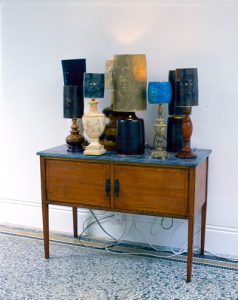Lyn French (A Space, Director) reflects on how we make meanings out of our experiences and the unconscious agendas that influence the stories we tell ourselves and each other. The images referred to are from our Emotional Learning Cards sets ‘What do you feel?’ and ‘How do we live well with others?’. She has also produced art-based worksheets on the same theme for use in therapy sessions, the classroom, art workshops or at home, which you can download for free via the Iniva Creative Learning website. These worksheets are based on a project part-funded by Newport Primary School entitled ‘A Place for Conversation’ which was delivered by Iniva and A Space over the summer term 2014.
We all translate our experiences into language. This may take the form of a series of on-going conversations with others about what has happened in the past or accounts of our more recent experiences. Perhaps we speak most openly with a close friend or maybe with someone trained to listen and make sense of what has – or is – happening such as a counsellor, a psychotherapist or a creative therapist. Or we might digest our experiences in short ‘bite-sized’ chunks through emails and text. Maybe we share our stories on a blog with a number of people who provide a ‘listening ear’ and respond by telling us about their similar experiences.
In this way, and through the stories we tell, we create our world. This is not so straightforward as it seems. As authors of our own worlds, we can edit or re-write our stories to better suit how we want to represent ourselves. We may put a positive spin on an account of our lives to better match the picture we want to project of the kind of person we ‘d like to believe we are. This ‘creative licence’ can be unconscious and comes to the fore when we are reflecting on difficult experiences. None of us like to own up to our role in situations where things have turned out badly. If, for example, a relationship breaks up because our partner is spending more time with someone else, it is easy to label the partner as ‘the bad one’ and to win our friends’ sympathy by painting ourselves as a victim. No story is this simple. All of us have parts to play in every relationship. Break-ups happen for many complex reasons, some of which we are aware of and some we will be less conscious of.
We need to take care with the stories we tell ourselves and then share with others. Whenever we repeat an account of a significant experience, we are not only telling the other about it but also reinforcing our own version of events, often distorting the reality in subtle ways. We do this because we all have a vested interest in preserving our good image. None of us wants to feel guilt or shame about our behaviour or how we’ve treated someone else. It’s more comfortable to find an angle on the story which rationalises why we did what we did or said what we said in the heat of the moment, preferably an angle which clearly puts ‘the other’ in the wrong.
‘Right / wrong’ and ‘black & white’ thinking avoids the complexities and ambiguities of thinking in shades of grey. Polarising like this only reinforces conflict. If we can admit to our role in a difficult encounter, a space can open up that is less confrontational. It can make us feel exposed or vulnerable but this doesn’t have to be something to be avoided. Often, vulnerability generates compassion and diffuses animosity.
All of us have an inner ‘script’ running all the time. It takes the form of a commentary that is narrating our lives. This ‘self-talk’ can support more reality-based thinking or, conversely, reinforce negative thoughts about ourselves and others. A useful way to check your self-talk is to become conscious of what you are saying to yourself when you get something wrong or make an error in judgement. What is your inner ‘voice’ telling you? Do you say to yourself, ‘How could you be so stupid! Now you’ve gone and ruined things!’ Or perhaps your ‘self-talk’ takes a different angle, commenting along the following lines: ‘That was the wrong thing to do! I wonder how I can remedy the situation. Maybe I just need to admit my mistake and take it from there.’

Bani Abidi Intercommunication Devices , 2008
Bani Abidi’s series of photographs, 2008 (see above) puts communication centre stage. By focusing in on these ‘devices’ Abidi makes us think about how we communicate with others and who we ‘let in’. We can extend this analogy and reflect on ‘what’ we let in as well as ‘who’. What stories about others or about ourselves do we choose to take in and believe as fact? If someone seems to be critical of our accent or how we look, or what we do, do we give their opinion more status than our own? Do we then feed a negative image of ourselves? Or do we say in our thoughts, ‘I hear your view but I don’t agree. I know who I am and I know my value.’
Families often edit stories from the past. Perhaps relatives who have done well are given ‘star billing’ while others who have struggled or have been in trouble in some way are ‘erased’ from the family narrative. Becoming conscious of what we let into our mind, how we frame our stories about self and other and how we use language is a vital life skill. Unconscious prejudices and assumptions about race, gender, class and culture are perpetuated in nuanced ways if we do not manage our thoughts and question our biases. We also need to take care with our self-image so that we avoid the extremes of either inflating our own image or denigrating ourselves. Language is the primary tool we have to construct our worlds and create and sustain healthy relationships with self and other. We need to use it mindfully.

Francis Upritchard ‘Grandma’s Lamps (2006)
Like the lamps arranged on the sideboard in Francis Upritchard’s image Grandma’s Lamps 2006 (above), we all share features in common with each other but we have differences too. The way we describe these differences to ourselves in our ‘self-talk’ may need to be monitored and perhaps gently challenged.
Did you like this blog? Download the free resource to accompany it The Stories that Make Us: exploring personal histories found within the resources tab on the Iniva Creative Learning website. For more on the project developed with Newport Primary School visit the Iniva learning project page.